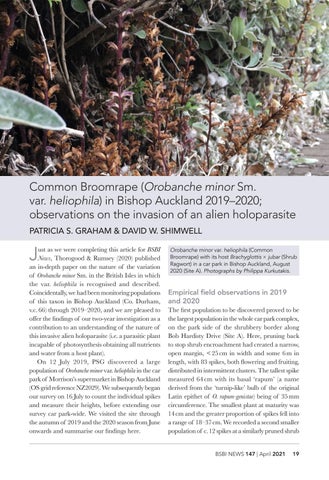Common Broomrape (Orobanche minor Sm. var. heliophila) in Bishop Auckland 2019–2020; observations on the invasion of an alien holoparasite PATRICIA S. GRAHAM & DAVID W. SHIMWELL
J
ust as we were completing this article for BSBI News, Thorogood & Rumsey (2020) published an in-depth paper on the nature of the variation of Orobanche minor Sm. in the British Isles in which the var. heliophila is recognised and described. Coincidentally, we had been monitoring populations of this taxon in Bishop Auckland (Co. Durham, v.c. 66) through 2019–2020, and we are pleased to offer the findings of our two-year investigation as a contribution to an understanding of the nature of this invasive alien holoparasite (i.e. a parasitic plant incapable of photosynthesis obtaining all nutrients and water from a host plant). On 12 July 2019, PSG discovered a large population of Orobanche minor var. heliophila in the car park of Morrison’s supermarket in Bishop Auckland (OS grid reference NZ2029). We subsequently began our survey on 16 July to count the individual spikes and measure their heights, before extending our survey car park-wide. We visited the site through the autumn of 2019 and the 2020 season from June onwards and summarise our findings here.
Orobanche minor var. heliophila (Common Broomrape) with its host Brachyglottis × jubar (Shrub Ragwort) in a car park in Bishop Auckland, August 2020 (Site A). Photographs by Philippa Kurkutakis.
Empirical field observations in 2019 and 2020
The first population to be discovered proved to be the largest population in the whole car park complex, on the park side of the shrubbery border along Bob Hardisty Drive (Site A). Here, pruning back to stop shrub encroachment had created a narrow, open margin, < 25 cm in width and some 6 m in length, with 83 spikes, both flowering and fruiting, distributed in intermittent clusters. The tallest spike measured 64 cm with its basal ‘rapum’ (a name derived from the ‘turnip-like’ bulb of the original Latin epithet of O. rapum-genistae) being of 35 mm circumference. The smallest plant at maturity was 14 cm and the greater proportion of spikes fell into a range of 18–37 cm. We recorded a second smaller population of c. 12 spikes at a similarly pruned shrub BSBI NEWS 147 | April 2021
19
















